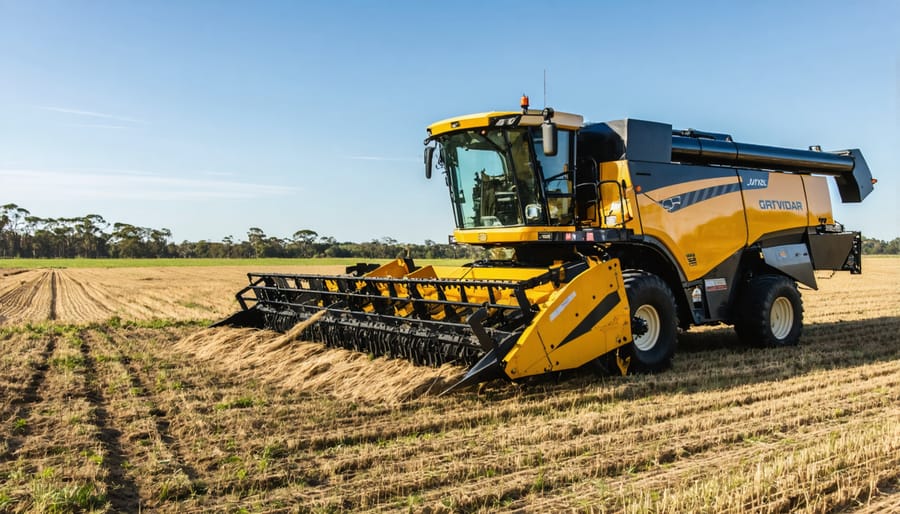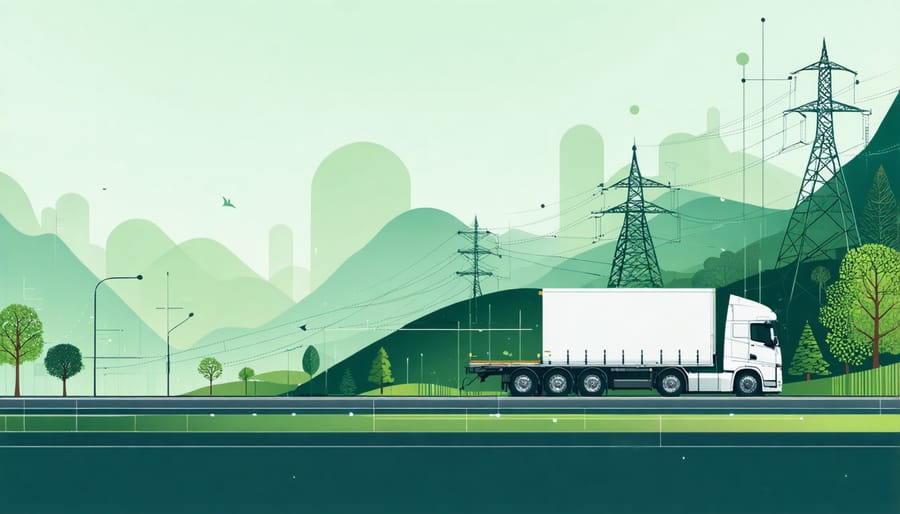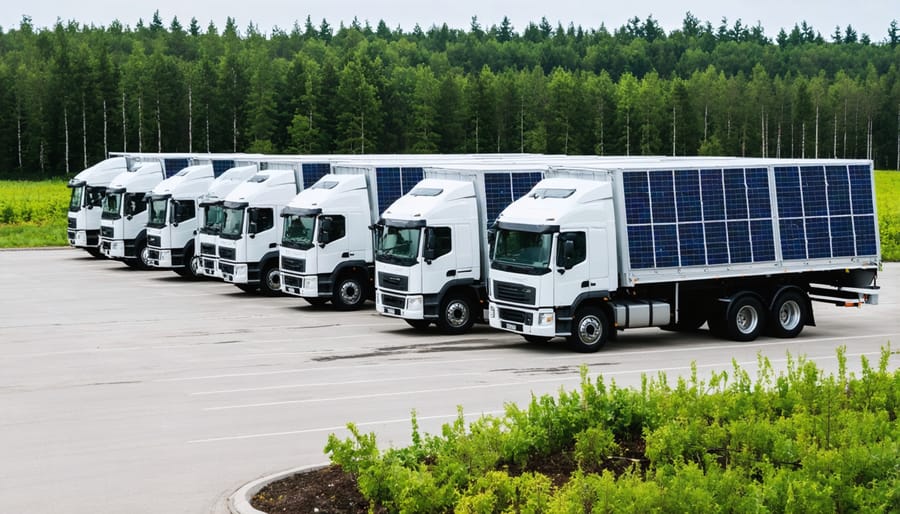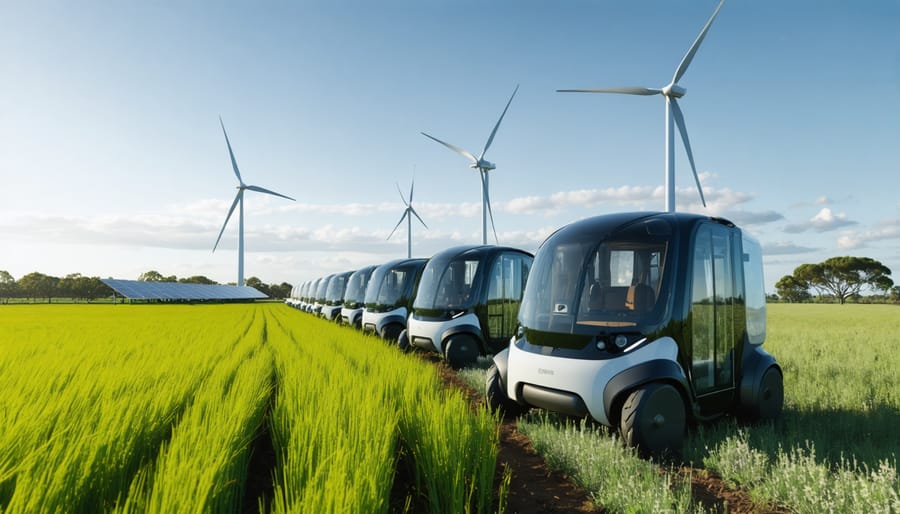Transportation stands at the cusp of a revolutionary transformation, driven by unprecedented technological breakthroughs and an urgent need for sustainable solutions. From autonomous vehicles navigating city streets to smart biomass supply chains revolutionizing energy logistics, innovations are reshaping how we move people, goods, and resources across Australia and beyond. These advancements promise not just improved efficiency and reduced environmental impact, but a fundamental reimagining of our relationship with mobility.
The convergence of artificial intelligence, renewable energy, and advanced materials science has unlocked possibilities that seemed like science fiction just a decade ago. Electric vehicles now compete with traditional combustion engines on both performance and price, while hyperloop technology and electric vertical takeoff and landing (eVTOL) aircraft challenge our traditional notions of distance and travel time. In our cities and regions, these innovations are already transforming daily life, creating cleaner, quieter, and more connected communities.
As we stand at this pivotal moment, the innovations emerging in transportation technology offer more than just solutions to logistical challenges – they represent a pathway to a more sustainable and equitable future for all Australians.
Advanced Biomass Collection Systems
Automated Harvesting Solutions
The landscape of biomass collection has been revolutionized by cutting-edge automated harvesting solutions that combine efficiency with environmental stewardship. Modern agricultural robots and smart machinery are transforming how we gather biomass resources across Australia’s vast agricultural regions. These innovations employ smart harvesting techniques that minimize soil compaction and protect native vegetation while maximizing yield.
Leading the charge are autonomous harvesters equipped with precision sensors and GPS guidance systems. These machines can operate around the clock, adapting to different terrain conditions and identifying optimal collection patterns. In Queensland’s sugarcane fields, for instance, automated harvesters now collect crop residue with 40% greater efficiency than traditional methods, while reducing fuel consumption by nearly a third.
Artificial intelligence plays a crucial role in these systems, helping machines distinguish between harvestable biomass and protected species or sensitive ecosystems. This technology has proven particularly valuable in managing mixed-species plantations, where selective harvesting is essential for sustainable resource management.
Real-time monitoring capabilities allow operators to track harvesting progress, moisture content, and biomass quality from remote locations. This data-driven approach ensures optimal timing for collection and helps maintain consistent supply chains for bioenergy facilities. Many farmers report that these automated solutions have not only improved their operational efficiency but also contributed to better land management practices and reduced environmental impact.

Mobile Preprocessing Technology
Mobile preprocessing technology is revolutionising how we handle biomass transport across Australia’s vast landscape. These innovative solutions bring the processing facility directly to the source, dramatically reducing transportation costs and environmental impact. Purpose-built mobile units now enable efficient waste-to-energy conversion right where the biomass is generated.
Leading the charge are compact mobile chippers and pelletisers that can process up to 20 tonnes of biomass per hour. These units feature smart sensors that automatically adjust processing parameters based on material moisture content and density, ensuring consistent output quality. Solar-powered monitoring systems track processing efficiency and maintenance needs in real-time, even in remote locations.
One standout innovation is the development of mobile densification units that can reduce biomass volume by up to 80%, making transport significantly more efficient. These units are particularly valuable for agricultural regions, where farmers can now process crop residues on-site instead of burning them or paying for expensive transport.
The technology’s impact is already evident in Queensland’s sugar cane industry, where mobile preprocessing has reduced transport costs by 45% while cutting associated carbon emissions. This success has inspired similar initiatives across other agricultural sectors, demonstrating how smart preprocessing solutions can make biomass transport more viable and sustainable.
Smart Logistics Networks
AI-Powered Route Optimization
In the heart of Australia’s biomass transport revolution, artificial intelligence is reshaping how we move renewable resources across our vast continent. Smart algorithms are now crunching massive amounts of data to determine the most efficient routes for transporting biomass materials from collection points to processing facilities.
These AI-powered systems consider multiple variables simultaneously – from weather patterns and road conditions to fuel consumption and delivery windows. For instance, in Queensland’s sugarcane regions, AI routing has reduced transport costs by up to 25% while cutting emissions by optimizing truck loads and minimizing empty return trips.
The technology adapts in real-time to changing conditions, something that traditional routing methods simply couldn’t achieve. When heavy rains affect certain routes in Northern NSW, the AI automatically recalculates alternatives, ensuring biomass deliveries stay on schedule while avoiding flood-prone areas.
What’s particularly exciting is how these systems learn and improve over time. By analyzing historical data from successful deliveries, the AI continues to refine its recommendations, creating increasingly efficient transport networks. Some operators report seeing a 15-20% improvement in delivery times within just six months of implementation.
Leading Australian transport companies are combining AI route optimization with GPS tracking and weather monitoring systems. This integration creates a comprehensive logistics solution that not only plans the best routes but also provides real-time updates to drivers and facility managers.
The future looks even more promising as these systems begin incorporating drone footage and satellite data to enhance their decision-making capabilities. For rural communities depending on reliable biomass transport, this technology isn’t just about efficiency – it’s about building a more resilient and sustainable energy supply chain.

Real-time Tracking Systems
Modern transport fleets are being revolutionised by sophisticated real-time tracking systems that have transformed how we monitor and manage deliveries. These innovative technologies combine GPS tracking, IoT sensors, and artificial intelligence to create a seamless web of information that keeps stakeholders informed at every step of the journey.
In Australia, transport companies are increasingly adopting smart tracking solutions that provide minute-by-minute updates on vehicle location, cargo conditions, and estimated arrival times. These systems go beyond simple location tracking, incorporating temperature monitoring for sensitive cargo, fuel efficiency analytics, and even driver behaviour insights to optimise route planning and reduce environmental impact.
One standout feature of contemporary tracking systems is their ability to adapt to changing conditions in real-time. When traffic congestion occurs or weather conditions deteriorate, these systems automatically recalculate routes and update delivery schedules, ensuring maximum efficiency while keeping customers informed through automated notifications.
The integration of blockchain technology has added an extra layer of security and transparency to tracking systems. Each transaction and movement is recorded in an immutable digital ledger, creating an unbroken chain of custody that’s particularly valuable for high-value or sensitive cargo.
For fleet managers, these systems provide comprehensive dashboards that offer instant visibility across their entire operation. They can monitor vehicle maintenance schedules, identify potential delays before they occur, and make data-driven decisions to improve overall fleet performance.
The environmental benefits are significant too, with real-time tracking helping to reduce unnecessary fuel consumption and emissions through optimised routing and reduced idle time. This technology is proving essential in Australia’s push toward more sustainable transport solutions.
Sustainable Transport Solutions
Electric Transport Fleet
Electric vehicles are revolutionising the biomass transport sector, offering a sustainable solution that aligns perfectly with the renewable energy industry’s values. Leading Australian logistics companies are increasingly adopting electric trucks for short to medium-haul biomass deliveries, reducing both emissions and operating costs.
In Queensland’s renewable energy corridor, several biomass facilities have successfully integrated electric transport fleets, with vehicles capable of carrying up to 30 tonnes of processed biomass materials. These electric trucks feature advanced battery technology that provides a range of up to 400 kilometers on a single charge, making them ideal for regional deliveries.
The benefits extend beyond environmental impact. Fleet operators report up to 60% reduction in maintenance costs compared to traditional diesel vehicles, thanks to fewer moving parts and simplified mechanical systems. The quieter operation of electric vehicles also makes them perfect for early morning deliveries in urban areas, addressing noise pollution concerns.
Innovation continues with the development of smart charging infrastructure at biomass processing facilities. These charging stations often utilize solar power, creating a completely sustainable transport cycle. Some facilities have implemented battery swap systems, enabling continuous operation without lengthy charging downtimes.
The transition to electric transport fleets demonstrates Australia’s commitment to reducing carbon emissions while maintaining efficient biomass logistics. With government incentives supporting the shift to electric vehicles, many operators are finding the initial investment increasingly feasible and attractive.

Renewable-Powered Transport Hubs
Australia’s transport hubs are undergoing a remarkable transformation, embracing renewable energy solutions to create more sustainable infrastructure. Leading the way is Melbourne’s Southern Cross Station, which has integrated an extensive solar panel system that powers nearly 60% of its daily operations. This innovative approach to clean energy production innovations demonstrates how major transport facilities can significantly reduce their carbon footprint.
In Brisbane, the newly developed Cross River Rail stations are incorporating state-of-the-art renewable energy systems, including solar-powered lighting, regenerative braking technology that captures and reuses train braking energy, and smart climate control systems powered by renewable sources. These initiatives are expected to reduce the network’s energy consumption by up to 35%.
Sydney’s transport infrastructure is also making impressive strides with the implementation of wind turbines at select metro stations, complemented by battery storage systems that ensure consistent power supply during peak hours. The integration of these renewable technologies isn’t just environmentally sound – it’s proving to be economically viable, with an estimated return on investment within seven years.
Regional transport hubs haven’t been left behind, with places like Newcastle’s interchange featuring innovative geothermal cooling systems and smart LED lighting powered entirely by renewable sources. These developments are setting new benchmarks for sustainable transport infrastructure across the country, proving that the future of transportation can be both efficient and environmentally responsible.
Australian Success Stories
The success of biomass transport innovations in Australia is best exemplified by several groundbreaking projects that have transformed the industry. In Western Australia, the Warmun Community Initiative showcases how remote areas can benefit from efficient biomass logistics. By implementing a mobile pelletising system, the community reduced transport costs by 60% while creating local employment opportunities.
Another remarkable achievement comes from the Green Triangle region, spanning South Australia and Victoria. Here, a consortium of timber processors revolutionised their transport system by introducing smart scheduling software and modular truck designs. This innovation increased payload capacity by 25% and reduced empty return trips by 40%, setting new standards for efficiency in the industry.
Queensland’s sugar industry demonstrates how agricultural waste can be transformed into valuable energy resources. The Mackay Sugar Cooperative pioneered a sophisticated bagasse transport network, connecting three mills with a renewable energy facility. Their automated loading systems and purpose-built containers have slashed handling times by half while maintaining material quality.
The Tasmania Biomass Network stands out for its innovative approach to maritime transport. By converting decommissioned cargo vessels into specialized biomass carriers, they’ve created a cost-effective solution for moving wood waste between coastal communities. This initiative not only reduced road transport emissions but also opened new markets for previously underutilized resources.
In New South Wales, the Hunter Valley Biomass Hub demonstrates the power of collaboration. Five major agricultural producers pooled resources to create a shared transport infrastructure, including smart storage facilities and a fleet of hybrid vehicles. This cooperative approach has resulted in a 30% reduction in operational costs and significantly improved supply chain reliability.
These success stories highlight Australia’s capacity for innovative thinking in biomass transport. They demonstrate how combining technological advancement with practical solutions can create sustainable, efficient systems that benefit both the environment and local communities.
The transportation sector stands at the cusp of a remarkable transformation, with innovations reshaping how we move people and goods across Australia and beyond. These advancements are not just improving efficiency and convenience; they’re actively contributing to a more sustainable future. From electric vehicles becoming increasingly mainstream to the emergence of autonomous transport solutions, we’re witnessing a revolution that promises to dramatically reduce our carbon footprint while enhancing mobility for all.
The convergence of artificial intelligence, renewable energy, and smart infrastructure is creating unprecedented opportunities for cleaner, safer, and more accessible transportation systems. As we look ahead, we can expect to see even more groundbreaking developments, including the widespread adoption of hydrogen-powered vehicles, advanced aerial mobility solutions, and hyperloop systems that could revolutionise interstate travel.
The future outlook is particularly promising for regional Australia, where these innovations could bridge vast distances while preserving our unique environmental heritage. With continued investment in research and development, supportive policy frameworks, and growing public acceptance, these transportation innovations are set to transform our cities and communities into more liveable, connected spaces.
The journey toward sustainable transportation is well underway, and Australia is positioned to be a leader in this global transition. By embracing these innovations today, we’re not just investing in better transport solutions – we’re paving the way for a cleaner, more efficient, and more equitable tomorrow.

